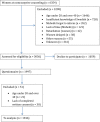Contraceptive use and reproductive intentions among women requesting contraceptive counseling
- PMID: 30007091
- PMCID: PMC6175138
- DOI: 10.1111/aogs.13426
Contraceptive use and reproductive intentions among women requesting contraceptive counseling
Abstract
Introduction: Limited attention has been paid to the use of contraception in relation to women's family planning intentions. The aim of this study was to investigate the use of contraception during the most recent intercourse as well as the reproductive intentions of Swedish-speaking women requesting contraceptive counseling.
Material and methods: A cross-sectional baseline survey in a randomized controlled trial regarding reproductive life planning (before randomization). Women requesting contraceptive counseling answered questions about contraception and whether they wanted to have children/more children in the future.
Results: In total, 1946 women participated: 33.7% (n = 656) parous and 65.7% (n = 1279) nulliparous. The majority, 87.1% (n = 1682), had used contraception during their latest intercourse; 64.6% (n = 1239) used short-acting reversible contraception, 22.8% (n = 443) used long-acting reversible contraception (LARC), and 12.9% (n = 251) had not used any contraception. A combined oral contraceptive was more common among nulliparous and LARC among parous. Among all women, 64.8% (n = 1253) intended to have children/more children in the future, among parous women 35.7% (n = 220) and among nulliparous 80.0% (n = 1033). Among women who did not intend to have children/more children, 22.6% (n = 60) of parous and 10% (n = 8) of nulliparous had not used contraceptives during their most recent intercourse.
Conclusions: Women did not always use contraceptives that were suitable for their reproductive intentions. Questioning women who request contraceptive counseling about their pregnancy intention can give healthcare providers better opportunities for individualized counseling.
Keywords: contraception; counseling; long-acting reversible contraception; preconception care; reproductive health; unintended pregnancy; unplanned pregnancy.
© 2018 The Authors. Acta Obstetricia et Gynecologica Scandinavica published by John Wiley & Sons Ltd on behalf of Nordic Federation of Societies of Obstetrics and Gynecology (NFOG).
Figures
Similar articles
-
An intervention in contraceptive counseling increased the knowledge about fertility and awareness of preconception health-a randomized controlled trial.Ups J Med Sci. 2019 Aug;124(3):203-212. doi: 10.1080/03009734.2019.1653407. Epub 2019 Sep 9. Ups J Med Sci. 2019. PMID: 31495254 Free PMC article. Clinical Trial.
-
Effects of structured contraceptive counseling in young women: Secondary analyses of a cluster randomized controlled trial (the LOWE trial).Acta Obstet Gynecol Scand. 2024 Nov;103(11):2242-2251. doi: 10.1111/aogs.14954. Epub 2024 Sep 26. Acta Obstet Gynecol Scand. 2024. PMID: 39327830 Free PMC article. Clinical Trial.
-
Unintended pregnancy and subsequent postpartum long-acting reversible contraceptive use in Zimbabwe.BMC Womens Health. 2018 Nov 26;18(1):193. doi: 10.1186/s12905-018-0668-z. BMC Womens Health. 2018. PMID: 30477497 Free PMC article.
-
Canadian Contraception Consensus (Part 1 of 4).J Obstet Gynaecol Can. 2015 Oct;37(10):936-42. doi: 10.1016/s1701-2163(16)30033-0. J Obstet Gynaecol Can. 2015. PMID: 26606712 English, French.
-
Family Planning Counseling for Women Living with HIV in Low- and Middle-Income Countries: A Systematic Review of the Impact on Contraceptive Uptake, Intention to Use Contraception and Pregnancy Incidence, 2011 to 2022.AIDS Behav. 2024 Aug;28(8):2477-2491. doi: 10.1007/s10461-024-04319-w. Epub 2024 Apr 25. AIDS Behav. 2024. PMID: 38662281 Free PMC article.
Cited by
-
An intervention in contraceptive counseling increased the knowledge about fertility and awareness of preconception health-a randomized controlled trial.Ups J Med Sci. 2019 Aug;124(3):203-212. doi: 10.1080/03009734.2019.1653407. Epub 2019 Sep 9. Ups J Med Sci. 2019. PMID: 31495254 Free PMC article. Clinical Trial.
-
Contraceptive choices and satisfaction: a cross-sectional analysis of sociodemographic influences.Ups J Med Sci. 2025 Jul 29;130:12656. doi: 10.48101/ujms.v130.12656. eCollection 2025. Ups J Med Sci. 2025. PMID: 40761633 Free PMC article.
-
Choices and services related to contraception in the Gaza strip, Palestine: perceptions of service users and providers.BMC Womens Health. 2019 Dec 19;19(1):165. doi: 10.1186/s12905-019-0869-0. BMC Womens Health. 2019. PMID: 31856794 Free PMC article.
-
Quality of websites about long-acting reversible contraception: a descriptive cross-sectional study.Reprod Health. 2019 Nov 27;16(1):172. doi: 10.1186/s12978-019-0835-1. Reprod Health. 2019. PMID: 31775765 Free PMC article.
-
Women's experiences of dealing with fertility and side effects in contraceptive decision making: a qualitative study based on women's blog posts.Reprod Health. 2023 Jun 29;20(1):98. doi: 10.1186/s12978-023-01642-8. Reprod Health. 2023. PMID: 37381022 Free PMC article.
References
-
- Cheng D, Schwarz EB, Douglas E, Horon I. Unintended pregnancy and associated maternal preconception, prenatal and postpartum behaviors. Contraception. 2009;79:194‐198. - PubMed
-
- Shah PS, Balkhair T, Ohlsson A, Beyene J, Scott F, Frick C. Intention to become pregnant and low birth weight and preterm birth: a systematic review. Matern Child Health J. 2011;15:205‐216. - PubMed
-
- Black A, Guilbert E, Co A, et al. Canadian contraception consensus (Part 1 of 4). J Obstet Gynaecol Can. 2015;37:936‐942. - PubMed
MeSH terms
LinkOut - more resources
Full Text Sources
Other Literature Sources
Medical


